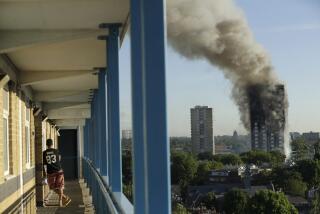Experts Differ on Peril From Smoke
NEW YORK — A vast choking plume of smoke from the ruined World Trade Center has engulfed much of lower Manhattan, stinging eyes like tears and searing lungs since the towers were destroyed in a terrorist attack Tuesday.
Federal health officials say the fumes, which at times have extended over parts of Queens and Brooklyn as well, pose no serious hazard to the millions of people breathing them. But other experts warn that it is too soon to draw such a conclusion.
The acrid billows have stirred fears of possible airborne asbestos fibers and a witch’s brew of toxic chemicals that might have been created as the towers burned.
Many experts said Thursday that it is too soon to know what fumes were forged in the furnace of burning jet fuel, insulation and other synthetic materials that consumed one of the most heavily computerized office complexes in the world.
As the wind has shifted from hour to hour, the smoke and ash have driven indoors the children playing on swings in Washington Square. Pedestrians in Greenwich Village and window shoppers on Park Avenue have worn cotton masks, wrapped shirts around their faces and otherwise done their best to ignore the corrosive stench of terrorism.
At night, dust and ash swirl around the wreckage, illuminated by the spotlights shining down on the site. Black smoke leaks out of the rubble. Rescue workers stumble out of the debris, their eyes red and faces sooty.
Despite the masks worn by workers and volunteers, the ash seeps through, coating people’s throats. The smoke rises and forms a heavy curtain over the mountain of rubble, blocking out the sky.
Based on tests around New York and New Jersey, U.S. Environmental Protection Agency officials said Thursday that they could find no elevated levels of asbestos, lead or volatile organic compounds in residential areas outside the immediate vicinity of the Trade Center. They even scraped the powdered ash from a wrecked police car at the Trade Center to analyze the chemistry of the talc-like dust.
“The good news for the residents of New York is that the air, while smoky, is not dangerous,” said EPA spokeswoman Tina Kreisher in Washington. “There are dangers of smoke from the fire, of course, but it is not something we would classify as toxic.”
But independent authorities on environmental health and air quality were more cautious and discounted the EPA tests.
“I don’t think preliminary tests will tell us what has been deposited in the neighborhoods and in the lungs of people breathing it,” said environmental health expert Paul Lioy of Rutgers University.
The tools of the terrorist attack--passenger jets laden with aviation fuel--made the aftereffects on air quality even worse.
“You had highly volatile fuel, which leads to a very hot fire,” Lioy said. “That will lead to the evaporation of plastics and [other] synthetic materials in the building and the wiring. It also probably vaporized some of the metals in the structure.”
Experts at UC San Diego, New York University and the Massachusetts Institute of Technology all cautioned that there is no easy way to assess the unique mixture of potentially toxic chemicals and soot created in the collapse of the twin 110-story towers. It is equally hard to gauge any long-term health effects.
“There is such a mix--jet fuel, the dust from the buildings and the cement, burning electronics, all the wires and the melting pipes--you have to be worried,” said atmospheric chemistry expert Kimberly Prather of UC San Diego.
Given the uncertainties about the health effects, “I would be plain-out concerned about what people have been breathing. Nobody really knows how the different chemicals will affect people,” she said.
Caltech chemical engineering expert John Seinfeld, who specializes in the study of particulate pollution, said relatively brief exposures to the fumes from the wreckage may not cause long-term health damage. Even so, “You don’t want to be breathing this material in high concentrations up close,” he said.
The greatest risk is to rescue workers, said Dr. Philip Landrigan of the Mount Sinai School of Medicine in New York. Those exposed to the initial fire or to hot spots in the wreckage risk thermal injuries, which can produce redness, swelling and ulceration, impair breathing and make people more susceptible to the impact of soot and dust in the air.
“Those construction workers, firefighters and cops are being very heavily exposed to dust and asbestos. That [exposure] isn’t going to end tomorrow; they’ll be heavily exposed for weeks and months,” he said.
As for everyone else, the continuing release of smoke and gases into the air is likely to intensify the classic impacts of air pollution--exacerbating asthma, emphysema and coronary disease for many vulnerable people nearby.
Health officials have recommended that New Yorkers do their best to avoid undue exposure to the smoke. The advice is particularly important for children, the elderly, women and people with heart or respiratory conditions, Landrigan said.
“We recommend people limit their time outdoors, be careful about heavy outdoor activity like running and be prudent,” he said.
Hotz reported from New York and Polakovic from Los Angeles. Times health writer Jane E. Allen contributed to this story.
More to Read
Sign up for Essential California
The most important California stories and recommendations in your inbox every morning.
You may occasionally receive promotional content from the Los Angeles Times.










